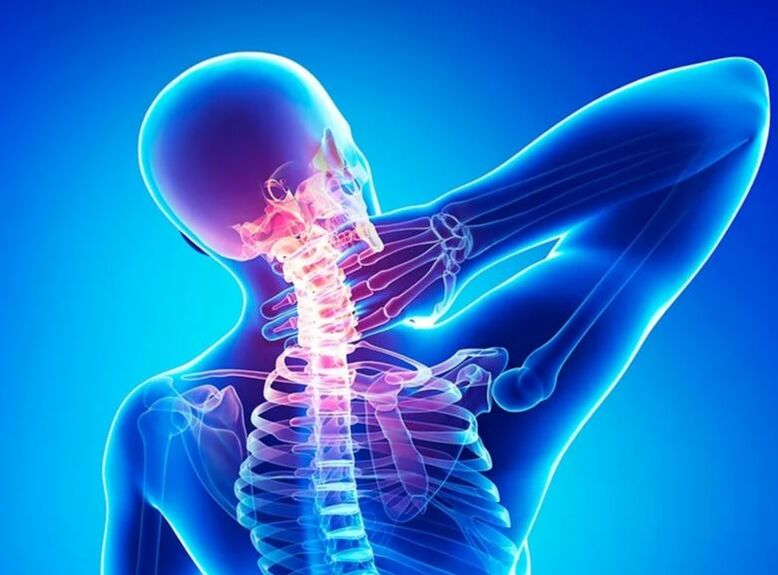
A description of illness
Osteochondrosis is the abnormal condition of the bone fraud tissue of the spine.The disease is characterized by dynamic changes and a reduction in the shock of the intervertebral discs.The pathology provokes the deterioration of the spinal column's capacity due to a decrease in the height of intervertebral discs and a reduction in the sound of the spinal muscles and ligaments.
Many forms of osteochondrosis can be distinguished depending on the localization of dystrophic changes: cervix, chest, lumbar, sacred.One of the most common cervical osteochondrosis (up to 25% of the total).The disease accompanies discomfort that significantly reduces the quality of human life.
It is noteworthy that cervical osteochondrosis can occur at any age.Currently, the disease is often diagnosed even in schoolchildren and students, which are related to a sedentary lifestyle and long -term stay on your computer and textbooks (depending on poor posture).
In the absence of treatment, the progression of osteochondrosis is increasingly pronounced, often complications: intervertebral hernia, nerve bite, circulatory, hypoxia, etc.
Symptoms
With the cervical osteochondrosis, there is insufficient nutrition in the cervical region's vertebra disks, from which they become fragile and the distance between them is significantly reduced.At the same time, bone tissue becomes prone to the increase and formation of bone growth (osteophytes).In later stages, growth moves and begins to squeeze nearby tissues, blood vessels and nerves that take place in the cervix region.
Cervix osteochondrosis- Chronic, gradually developing disease.Therefore, the symptoms of pathology differ in different stages.
- Symptoms of osteochondrosis of degree 1
At the initial stage of the disease, the height of the intervertebral disc of the cervix is slightly reduced.Pathology has mild symptoms.There is a discomfort in the neck that can spread to the shoulders.In some cases, cervical pain may occur in physical activity. - Symptoms of osteochondrosis of degree 2
At this stage, the height of the disk continues to decrease, the cartilage tissue is incorrectly increasing, and protrusion develops.Cracks can develop in the fibrous ring.The pain begins to increase, becomes longer, can radiate into your hands and spine.There is a feeling of stiffness with the turn of the neck, crunching and the appearance of headaches. - Symptoms of osteochondrosis of degrees 3
In the third stage of the disease, the fibrous ring is interrupted and the formation of intervertebral hernia.The spinal column is deformed and the vertebrae dislocation or subluxation may occur.The patient feels acute, prolonged pain in his neck, numbness, partial loss of the sensitivity of the chest skin in the chest, neck, shoulders or hands. - Symptoms of osteochondrosis at 4 degree
An irreversible change in the advanced stage of the disease occurs - many osteophytes develop, and the structure of the intervertebral disc is gradually replaced by scar tissue.The resulting hernia tightens a person to the blood vessels and nerves, the organs of organs have hypoxia, pathologies of the circulatory system.The pain lasts for a long time, the neck and upper shoulder belt immobilizes, and the quality of life deteriorates significantly.
Regardless of the severity of the disease, the patient may associate symptoms such as headache, noise or ears ringing, nausea, various vision impairment (blinking, darkness, pain).
Reasons
Cervical osteochondrosis is the result of inadequate distribution of the cervical spine.However, cervical muscles cannot cope with mechanical pressure, cramp, which leads to circulatory disorders.This is the degenerative changes in the upper spine.
Factors contributing to the development of osteochondrosis of the cervical spine:
- hereditary predisposition;
- cervical injury;
- sedentary lifestyle;
- Long stay in one position - at the computer, driving, etc.;
- The presence of autoimmune diseases rheumatoid arthritis, systemic lupus erythematosus,
- Scleroderma;
- violation of metabolism;
- Presence of endocrine diseases - gout, diabetes;
- Excessive weight.
Diagnosis
If you suspect the presence of osteochondrosis of the cervix, you should contact a medical institution on time.A comprehensive diagnosis promotes the identification of the disease, its degree and understands the causes of pathology.Preliminary diagnosis is made based on control and palpation - osteochondrosis is detected in the cervical muscles, and in some cases the deformation of the spine is noticeable.
After an objective diagnosis, the doctor will send the patient for further examination.
The following diagnostic methods are used to confirm the diagnosis:
- Magnetic resonance tomography;
- Radiography (side and straight);
- Multilayer computer tomography.
To determine the cause of the pathology, ultrasound examination of the nearby organs, the ECG of the heart, the duplex scanning of the blood vessels, the blood vessels and the urine can also be written.
Therapeutic treatment
By timely detection of cervical osteochondrosis, the disease can be used for therapeutic treatment.Unfortunately, osteochondrosis cannot be completely cured, however, therapy promotes further development of the disease, relieves discomfort and normalizes the upper spine mobility.
The following methods are used for this:
- Drug treatment.Medicines relieve pain and inflammation, restore blood circulation and eliminate the cramps of the neck muscles.The following groups of drugs can be used for this: glucocorticosteroids, analgesics, slow medicines, muscle relaxes, etc.
- Physiotherapy treatment.In addition to taking medicines to relax the cervical muscles, the elimination of cramps and normalization of blood circulation promotes physiotherapy procedures: massage, acupuncture, laser effect, magnetic therapy, UHF therapy, phonophoresis, etc.
- Therapeutic gymnastics.Special physical exercises help the patient strengthen the muscle frame, adjust posture and improve blood supply to the upper spinal column.
Surgery
Surgery is required for advanced stages of osteocondrosis of the cervix or with insufficient efficiency of conservative methods.
The following surgical methods can be applied to a special clinical case:
- Small invasive removal of spine hernia.
- Laminectomy is an operation for removal of spinal processes.
- Removal of hernia and stabilization of the operated segment using a system consisting of four titanium screws and two rod peaks.
- Endoscopic removal of hernia.



















